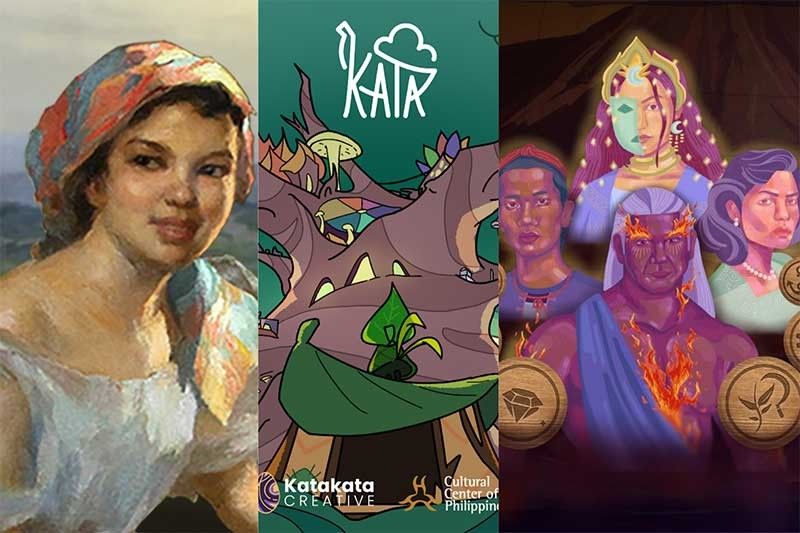These independent games shine the spotlight on Filipino arts, culture

MANILA, Philippines – Last year, the Cultural Center of the Philippines (CCP) launched different grants that “aim to generate original Intellectual Property (IP) content that reflects the country’s rich cultural heritage with its folktales, myths, and legends”.
With the program, CCP hoped to encourage local creative businesses, content developers, artists and students to create original content that featured Filipino culture.
Among the different grants was a Game Development Grant for the creation of a Filipino culture-inspired game, with the CCP helping developers by providing them access to the CCP Encyclopedia of Philippine Art.
With the help of the CCP grant, these three games have highlighted different aspects of Filipino culture for the appreciation of a new generation of gamers.
Join ‘Kata’ in rekindling the Filipino spirit
Katakata Creatives’ “Kata” is a platforming adventure game that features different quirky characters, breathtaking locations, and traditional music all inspired by Filipino culture and arts. Players will help rebuild Kata’s bahay kubo and climb to the top of the Narra tree all the while partaking in different Filipino traditions.
“When the Cultural Center of the Philippines announced that they would be giving grants to projects that showcased Filipino arts and culture, [the team] pitched ‘Kata’ as a challenging and engaging platforming game that also presented Filipino culture. We decided to go all-in on the cultural aspect of the game and make it more of an educational game aimed towards students and pre-teens,” recalled Angelo Barrera, founder and CEO of Katakata Creatives in an interview with Philstar.com.
Also the creative director behind the game, Barrera shared that the center of Kata had always been Filipino arts and culture, and that showcasing these were the cornerstone that made Kata the game it is currently.
“One of our main considerations while designing the game was its timelessness — will it still be relevant five, 10, 15 years from now?” said Barrera.
This consideration eventually led the team to making Kata an educational game, hoping to work with the Department of Education (DepEd) to make the game accessible to students nationwide.
He adds, “We are aiming to be an educational aid; if we can pull this off correctly then our game might be presented to students for years to come. And that really motivates us to do our best.”
The team targets a release by December 2023, refining the game further with feedback they have been receiving.
“We still plan on releasing the game in December of this year, but the steps after that will all depend on how our talks with the National Commission on Culture and Arts (NCCA) and DepEd go. We've made as many preliminary connections as we can and now it's time to present our project to DepEd in hopes that we can work together in bringing this to students.”
Those interested may wish-list Kata on Steam.
Dive into the art of Fernando Amorsolo with ‘San Fernando’
Makiling InterArts’ “San Fernando” will have players immersed in the art of National Artists Fernando Amorsolo. Players enter the game as an anthropologist assigned to learn more about the community of San Fernando, a distant island town.
“Fernando Amorsolo’s paintings were some of the first [things] that captivated us while looking for ideas for a game that incorporates Filipino culture. The more we read about his artworks and their history, the more we realized that they aligned perfectly with the kind of story that we wanted to tell,” San Fernando’s Narrative Designer and Composer, Matt Limbaga, told Philstar.com.
In the development of the game, the team was helped by CCP’s Encyclopedia of Philippine Art and were motivated to bring Amorsolo’s art to new life. The team had also contacted the Fernando C. Amorsolo Art Foundation who provided high definition images of Amorsolo’s paintings and were grateful for the foundation’s support.
“Our game fuses Amorsolo’s artworks with a modern medium. We hope that this combination would entice art enthusiasts, gamers, or anyone interested in Filipino art, culture, and anthropology to play our game, regardless of their age. We have learned so much about other cultures in the games that we play, what’s stopping us from putting our own culture in the same space?” said Limbaga.
The team hopes to release the full version of San Fernando by next year.
San Fernando is currently available to wish-list on Steam.
Discover the ‘Pearls of Asia’
In Caracoa’s Pearls of Asia, players dive into the rich history of Philippine trading and business practice with the help of different unsung heroes of Philippine history and mythology.
According to Caracoa co-founder, Joyce Ting, the birth of Pearls of Asia came from a desire to have a strategy game that features no war element.
“I was playing a game and then was attacked by a civilization [a game mechanic], which made me lose my in-game currency. Bakit may war element? What if, may game na pure trading lang, walang ibang mechanics. What would it look like? What if it’s set in a modern setting? And that was how Pearls of Asia was born,” Ting told Philstar.com.
Though the game has a very straightforward aspect, trade and earn money, the research and development behind the game had been the opposite.
“We decided to be as realistic as possible: be accurate with our production rate and selling prices in game, as well as incorporating the lore and history with our chosen characters,” added Ting.
Though the research was made easier with the team’s access to CCP’s archives, the team would see a challenge in something that their game heavily relies on: math.
“In making the game, we had some fun moments as well as not so fun moments. Ang pinakanahirapan kami is yung pagcombine ng math at graphics. Basically, integrating the trade aspect into what it would like in the game,” recalled Ting.
Besides the trading aspect, Pearls of Asia also highlights the unsung heroes of Filipino history. In the game, players would choose a Filipino hero, each with an individual strength in trading, to help them in their trading. It was a conscious decision from the team to make sure the chosen figures in their game were not ones one would expect.
“We actually tried to feature figures who were not involved much in the revolution. We chose Jose Rizal for his business background but besides him, many characters would be unfamiliar to most Filipinos. We searched for figures that had a business or an entrepreneurial background, because these people are not usually explored in our history classes. We wanted to feature historical figures that had an impact on the lives of Filipinos through their innovation,” shared Ting.
The game is currently undergoing further developments and hopes to release by early next year.
To know more about the game, visit Pears of Asia’s Official Facebook page.
- Latest
- Trending





























